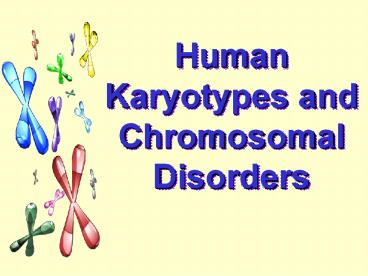Human Karyotypes and Chromosomal Disorders - PowerPoint PPT Presentation
1 / 48
Title:
Human Karyotypes and Chromosomal Disorders
Description:
Human Karyotypes and Chromosomal Disorders The incidence of the syndrome is estimated as 1 in 3,000 live births. The incidence increases as the mother's age increases. – PowerPoint PPT presentation
Number of Views:1121
Avg rating:3.0/5.0
Title: Human Karyotypes and Chromosomal Disorders
1
Human Karyotypes and Chromosomal Disorders
2
Looking At Chromosomes
- We can see chromosomes on a picture called a
karyotype.
3
Karyotype
- Photograph of chromosomes
- Grouped in order of homologous pairs
- Chromosome 1 is the longest and chromosome 22
is the shortest.
4
Making a Karyotype
- During prophase of mitosis
- biologists take pictures of the chromosomes
- Biologist then cut out the chromosomes and match
them up with their corresponding sister chromatid
starting with chromosome 1 (the longest
chromosome).
5
(No Transcript)
6
Importance of Karyotypes
- Allows a biologist to see if there are problems
with the chromosomes themselves. - i.e. extra chromosomes, parts missing, extra
parts added. - It helps make a diagnosis of a particular
condition - does not determine severity of condition.
7
(No Transcript)
8
Autosomes
- Chromosomes 1-22
- Non-sex chromosomes
9
Sex Chromosomes
- 23rd Pair of chromosomes
- XX female XY male
10
The X and the Y
- The X chromosome is almost three times as long as
the Y chromosome.
11
Sex DeterminationIn Humans
- Presence of a Y chromosome leads to maleness
- Father determines sex of child
12
(No Transcript)
13
Important!!
- Females can only donate an X
- All Female eggs have one X chromosome in them.
- Males can donate one X or one Y.
- The percentage is 50 X or 50 Y.
14
Determining Male and Female on a Karyotype
- Look at the 23rd chromosome location.
- Females will have two long chromosomes.
- Males will have a long and a short.
- Usually labeled as X and Y
15
Answer in your notes.
16
Answer in your notes.
17
(No Transcript)
18
Notation
- How do you write what you see on a karyotype?
- Look at number of chromosomes 46
- Look at the sex male or female
- Write number then male/ female chromosomes
- 46, XX or 46, XY
19
Notation 46, XY
20
Chromosomal Disorders
21
Nondisjunction
- Chromosomes segregate in meiosis,
- sometimes they do not segregate properly.
- The most common error in meiosis occurs when
homologous chromosomes fail to separate
NONDISJUNCTION! - Abnormal numbers of chromosomes may find their
way into gametes (egg and/or sperm).
22
//www.biostudio.com/d_20Meiotic20Nondisjunction
20Meiosis20I.htm
23
Down Syndrome Trisomy 21
- 3 chromosomes in the 21st position
- An extra chromosome is a called a trisomy
- Causes mental retardation and susceptibility to
diseases
24
- It affects over 350,000 people in the United
States alone and is the most common (1 in 800
live births) imbalance in the number of autosomes
in people.
25
Signs at Birth
- Low muscle tone (babies appear "floppy")
- Flat facial features, with a small nose
- Upward slant to the eyes
- Small skin folds on the inner corner of the eyes
- Hyperflexibility (excessive ability to flex
joints) - Enlarged tongue that tends to stick out.
26
Risks
- The risk of Down syndrome increases with age,
from about 1 in 1,250 for a woman at age 25, to 1
in 1,000 at age 30, 1 in 400 at age 35, and 1 in
100 at age 40.
27
(No Transcript)
28
(No Transcript)
29
Patau Syndrome-Trisomy 13
- It is a syndrome with multiple abnormalities,
many of which are not compatible with life. - Almost half of the affected infants do not
survive beyond the first month, and about three
quarters die within 6 months. - 1 in every 5,000 births
30
(No Transcript)
31
Signs of Patau
- Cleft lip and palate
- Mental retardation due to altered brain formation
- Congenital heart defects
- Close eyes or one eye, small eyes
- Deafness
32
Extra Finger.
33
Edwards Trisomy 18
- Extra 18th chromosome
- The syndrome has a very low rate of survival
resulting from - heart abnormalities
- kidney malformations
- other internal organ disorders.
- Most die within the mother.
34
- The incidence of the syndrome is estimated as 1
in 3,000 live births. - The incidence increases as the mother's age
increases.
35
Sex Chromosome Disorders
36
Turners Syndrome
- Female inherits only 1 X chromosome 45, XO
- This condition is an example of a monosomy the
presences of one chromosome where there should be
two. - Incidence - 12000 live female births.
37
- Symptoms include
- short stature
- lack of ovarian development
- webbed neck
- arms that turn out slightly at the elbow
- low hairline in the back of the head
38
Turners Karyotype
39
Webbed Neck, low hair line. Arms that turn out
slightly at the elbow.
40
Klinefelter Syndrome
- Men and boys with Klinefelter Syndrome have a Y
chromosome and 2 X chromosomes. This is an
example of trisomy. 47, XXY - This is also a problem of nondisjuction.
- Klinefelter Syndrome occurs in 1 in 500 to 1 in
1000 live births. - Develop as males with subtle characteristics that
become apparent during puberty. - Tall and usually do not develop secondary sex
characteristics such as facial hair, or underarm
and pubic hair
41
Symptoms/Signs
- Tall (around six feet)
- small testes or hypogodanism
- inability to produce sperm
- sparse facial and body hair
- gynecomastia
- low energy
- low self esteem
- motor skill issues
- developmental delays
- infertile
42
(No Transcript)
43
Practice Problems
44
(No Transcript)
45
(No Transcript)
46
(No Transcript)
47
(No Transcript)
48
(No Transcript)































